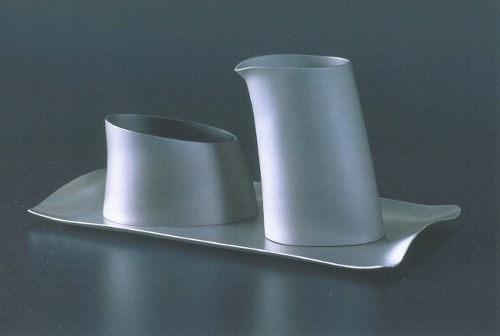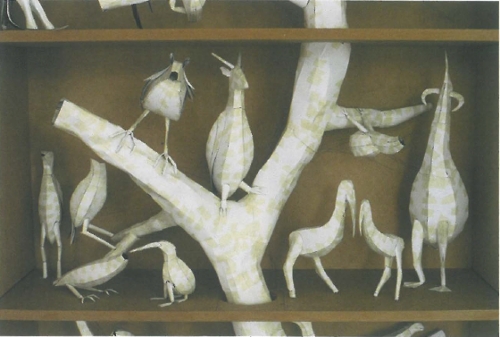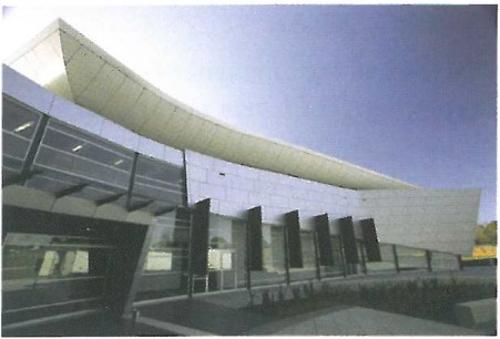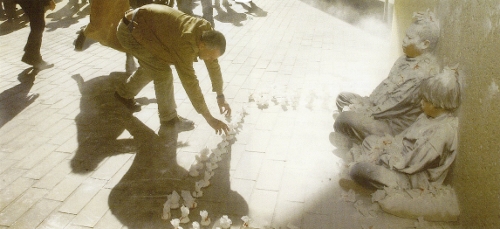Search
You searched for articles tagged with Technology ...

Nurturing the Handmade
In interacting with an object, its physical properties are paramount; as a result, the power of objects to affect us becomes identified with their physical attributes, leading to an emphasis on making, and so linking making with authorship. Sorzano explores the process of object-making as
the work in our minds, the work in our hands, and the work as a result...
.

The Hand in Making
The Tamworth Fibre Textile Biennial began in 1975 and every two years a collection of contemporary fibre textile work tours nationally to metropolitan and regional audiences. For Attiwill, guest curator of the 16th Biennial, the spark for the exhibition A Matter of Time came from Sue Rowleys wisdom: it is useful to think of craft in terms of multiple temporalities, A Matter of Time is an exploration of this usefulness.

Bush TV's: Piliyi - Good One
Nyinkka Nyunyu is an art and culture centre located on Warumungu land in Tennant Creek, right in the middle of the Northern Territory. From the time the idea came up to build something alongside the sacred site of Nyinkka Nyunya, art was always going to be an integral part of the project. The result of many brainstorming sessions amongst traditional owners of the land on which Tennant Creek stands was the idea of dioramas, or Bush TVs to provide the means to present history and contemporary life through art to a diverse audience.

Hand to Mouse: Design and the Handmade
There have always been cycles in the making of what we describe as art, crafts and design, where surges of new ideas have been followed by revivals of earlier values or reform movements that challenge both. The Powerhouse Museum, Sydney, is working on an exhibition for late 2006, on the interface between art, design, industry and the values of the handmade. Cochranes hope is that it will challenge audiences to look closely at some of the exciting working relationships that are possible.

In the Wake of Gesture: Architecture and the Handmade
Architecture has long since surrendered the tactile in favour of grander visions. Through an examination of Sandra Seligs recent work Synthetic Infinite at the Museum of Contemporary Art in Sydney and the unique responses to architecture and the handmade that this work displays, Murray attempts to question how we might then consider architecture and our relationship with built matter to restore a direct connection with human experience.

Domestic Arts in the White Cube
There exists an increasing number of artists - mostly women - creating art using what have been known, somewhat disparagingly, as domestic arts: knitting, crochet, sewing, tatting, embroidery. For many of these artists the choice of method is integral to what the work is saying, the making - the journey - as important as the result, even if that journey is not immediately obvious to the viewer.

Parallel Universe: The Gray St. Workshops @ 20
Gray Street Workshop, which is this year celebrating its twentieth anniversary, has pursued a creative work ethic closely aligned to values of the handmade, not as an end per se but as a means to evolve a creative language grounded in the interplay between ideas and practice.

Patrick Hall's Cabinets of Everyday Curiosities
For Hughes, Patrick Halls cabinets recall the great elaborately decorated cabinets of the 17th century. Rather than mere decoration, Halls cabinets express a poetry of the everyday that is neither a condescending celebration nor a critical analysis but a deeply personal response to his materiel.

Unpacking 'Il Cretino Veloci' or 'The Fast Idiot'
Thomson pays tribute to an increasing minority of Australians devalued for getting their hands in the mucky stuff. As he proclaims ...people who make things with their hands for a living are seen as a hopeless anachronism rooted to the ground. In an age where the majority of the Australian population now work in what are termed the service industries, the ability to apply ones motor skills are making for a society who rarely needs to use those funny slabs of flesh at the end of our arms.

Ecology: Everyone's Business
What does the onset of climate change mean to an artist today? We have known about species extinction for decades, and the death of ecosystems; artists whose work evolved around these issues first emerged during the sixties.

Batik and Kris: Duality of the Javanese Cosmos
Perc Tucker Regional Gallery 10 September - 7 November 2004

Living Together is Easy
National Gallery of Victoria: Ian Potter Centre, Melbourne 27 August - 7 November 2004 Contemporary Art Center, Art Tower Mito, Japan 24 January - 28 March 2004 Curated by Jason Smith and Eriko Osaka

Disorientate: Colour, Geometry and the Body
John Aslanidis, Paul Boam, John Dunkley-Smith, NeilHaddon, John Plapp, Wilma Tabacco Plimsoll Gallery, University of Tasmania, Hobart 15 October - 7 November 2004

Artifically Reconstructed Habitats: Finola Jones
Canberra Contemporary Art Space 13 August - 25 September 2004 Gertrude Contemporary Spaces, Melbourne 29 October - 20 November 2004

Fine Art Graduate and Honours Exhibitions Beyond
Griffith University, Queensland College of Art 24 - 27 November 2004 GraduArt 2004 Toowoomba Regional Gallery 27 November 2004 - 30 January 2005 modus vivendi Queensland University of Technology 3 - 5 November 2004

Christian de Vietri: The Nature of Things
Goddard de Fiddes Gallery, Perth 27 November - 18 December 2004

Petrified Nature: Julia Robinson and Morgan Allender, Birds and Bees, Louise Flaherty
Downtown Art Space, Adelaide 28 October - 6 November 2004 The Project Space, CACSA, Adelaide 29 October - 5 December 2004

Everyone Lives Downstream: James Darling and Lesley Forwood
Greenaway Art Gallery, Adelaide
24 November – 19 December 2004
24 November – 19 December 2004

Signs of the Times: Stephen Page, Sacred Symposium, Adelaide Biennale
Stephen Page is the first Artistic Director of the Adelaide Festival of Arts to be indigenous and his program for 2004 includes indigenous works but perhaps not many more than most Adelaide Festivals, which have always had a significant indigenous component. Yet there is a sense that the commissions that Page has initiated represent a maturity in approach and development that signifies a watershed for Indigenous culture in Australia. Page expects it to be optimistic, philosophical, constructive, to reflect on the fusion of the old and new without bastardization.

The Dave Inside
About the work and fame of Las Vegas based art writer Dave Hickey. Like all icons Dave comes with a portable, pocketable, mythology. A pungent blend of his own statements, press hype, rumour and dubious speculation.

Virtual Adelaide
One of the leading interactive groups to come out of Britain is the Blast Theory who are making interactive gaming projects, installations and mixed reality projects in various major cities of the world. They were based in Adelaide from January to March 2004 under the South Australian Premiers Thinkers in Residence Program in partnership with various other major Australian art corporations. Through the use of real and virtual city cityscapes there is an overlapping of concepts of time and space, with a focus on ideas of absence and presence amongst players online and those on the streets.

Beyond Adelaide
Brook looks at the role of geographic location throughout the ages of art theory and practice. The metaphor of adverse location prompted some baroque theorising about the metropolis as contrast-partner to the provinces...with the onset of neo-conservatism and the supervenience of economically rational accounts of virtue and of value the idea that art is peculiarly sensitive to location because it is more cultural than clothing and footwear came under challenge..
. Addressed in a context that concerns the locality of Adelaide, and beyond.

Young South Australian Art
This article is about hip young artists working outside the field of contemporary art.
Even if the changes of the last forty years have meant that liking things for being cool and fashionable has generally lost its polemical significance, my sense is that this still may hold some currency with regard to the specific condition of contemporary art in South Australia
. Strickland examines the work of South Australian artist Magosia Miow.

Wet Culture - Playing With Codes
Melentie Pandilovski, the Director of the Experimental Art Foundation in Adelaide, sees the current manifestation of the word experimental in Experimental Art Foundation as relating to biotechnology, consciousness and the places taken up by artist in scientific places where experiments are the usual tasks at hand. In a move away from dry hard-wired technologies the last five years has seen a rise of wetwork and a new subculture within science as artists find new roles in scientific laboratories and ask fresh moral, ethical and aesthetic questions.

Stories: Past, Present and Future
Franchesca Cubillo, the Artistic and Cultural Director of the National Aboriginal Cultural Institute, has a broad cultural background with Spanish Catholic and Filipino cultural infuences fusing seamlessly with her Aboriginal heritage. Aside from her administrative and managing roles at the institute she is also a painter and photographer. Maughan looks at Cubillos life and work as it is shaped through an appreciation of the importance of family and community.

Isolated Interventions
This article explores the artistic and economic viability of living and working in South Australia, a state with less than 400,000 people, most of whom reside in the south-eastern corner.
Theres enough professional isolation here to remind us that were living in a world where art is not a self-evident virtue
. As a result of living in the geographic margins, artists require considerable ingenuity, flexibility and lateral thinking in order to sustain a viable practice.

In the Far North-West
Colin Koch is the coordinator of Ku Arts, the artists representative and development body, a role which requires him to make the journey up into the northern regions of South Australia, land belonging to the Anangu people, once every six weeks. Koch discusses the significance of Ku Arts: some of the hurdles they have had to overcome and the subsequent milestones this regional indigenous arts centre has acheived.

Can Culture Save the River and Wetlands?
This question 'can culture save the river and wetlands'was put to a debating panel at the annual conference of Country Arts SA in October 2003. The river in question was the Murray. This article takes up some of the important issues surrounding environmental degredation and focuses on the SunRise 21 Artists in Industry Project which saw the collaboration of artists and organizations working together to establish a mutual relationship between arts and the environment.

The Second Experiment: Floating Land 2003
Floating Land 2003 was an event held as part of Noosa Regional Gallerys second major biennial site-specific art project that ended in high drama at 3am on the top of a mountain and one that unexpectedly created a new lobby group. The emphasis for this project was on experimentation both in terms of the art and the notion of what consitutes an event/festival that takes place over a period of time.

Ara Irititja: Protecting the Past, Accessing the Future - Indigenous Memories in a Digital Age
White fellatechnology was once considered a threat to Anangu culture and identity, but when iMacs, data-projectors and printers turned up in Anangu communities, they attracted a great deal of interest and excitement. The above mentioned title was an exhibition that opened at the South Australian Museum in October 2003 and comprised of three remarkable multimedia interactive databases which stand to offer unique opportunities to investigate pitjantjatjara and Yankunytjatjara peoples history and culture.

Community Arts and Artists in the Community
The Parks Arts & Functions Complex is situated in the Parks Community Centre in the Western suburbs of Adelaide, a region made up of many disadvantaged and minority groups. Weekly and fortnightly groups meet to explore different mediums and creative processes, and working without the assistance of a tutor means they rely on each other to develope their skills. The social benefits of these groups are often as important as the creative concerns. The centre invites guest artists to run various workshops to help sustain this interaction amongst members of the community.

Transfiguring ACMI
The Australian Centre for the Moving Image (ACMI) is now just a little over a year old. Housed in a purpose-built venue at Federation Square in Melbourne , ACMI is home to two multi-format cinemas, a variety of exhibition, education and production zones and the Screen Gallery, the largest of its kind in the world and, arguably, the jewel in ACMIs crown. Gye looks at the recent success of the new Screen Gallery and the future direction of ACMI.

Sacred Food: Elizabeth Nyumi
Like many of the people at Balgo, Elizabeth Nyumis early life was a nomadic existence with her family group on the Canning Stock Route. Whe her mother died she walked with her father into the old Catholic mission at Balgo. She began painting for Warlayirti Artists in 1988. Recently a very successful painter, she was invited to show at the 2004 Biennale of Sydney. OBrien examines Nyumis life and work.

The Real Thing: Recent Art of Derek Kreckler
The twenty-first century, it seems, will not be the age of manifestos. Like advertising campaigns and the design of cars and other consumer items, contemporary art has started to look the same....there is no agenda, no politics, no historical claims
. As McLean states, for Derek Kreckler, the point of being an artist today is not how well you resist this condition, but how well you can bend it to your own ends. Krecklers work is here positioned in a postminimalist rather than a postmodernist framework.

The Museum is the Message
The fifteen artists involved in Inside SAM's Place all acknowledge the shared language of art objects and museum artefacts.

Distance in our Lives
Exploring collaborations and their relationship to crossdiscipline and cross-cultural art practice is a key interest of Parallelo, South Australia's leading edge performance company. For over 18 years Parallelo have experimented with fusions of culture, media and artform as mediums for artistic expression and for new audience access.

Smart Strategy for Art Education
The marketing of senior secondary art achievement in South Australia, which has seen a rise in popularity in Year 12 art exhibitions, cannot be taken as proof of the depth and sustainability of visual art education in schools across all levels.

The Chapman Brothers
UK artists Jake and Dino Chapman have been the subject of public and media controversy since their emergence on the British art scene in the early 1990s. The Chapmans assert that their shock tactics are in aid of an examination of cultural taboos.
Parables of Criticism
Looks at the current issues in the art versus craft debate and the impact of post modern theories.
Thinking Craft, Crafting Thought
Toward a Typology of Small Objects
With increasing anxiety, we face searching questions of the viability, the integrity, the destiny of craft. In themselves, the questions are salutory and point to an intellectual vitality in craft culture, a vigour and toughness which have not existed since the Arts and Crafts Movement. Responses to the challenge vary from relish in the contradictions of craft practice to the old-fashioned despair for any debate whatsoever.
Thinking Craft, Crafting Thought
The Floating Web
For centuries now, textiles and the skills required in their creation - spinning, weaving, embroidery, sewing, quilting - have been considered women's work, occupying them indoors while men engaged in more serious activities like warfare.
Thinking Craft, Crafting Thought
Why Craftwork Does Not Compute
Will the computers, mobile or immobile, take over craft work in the near or medium future? Are craftspeople doomed to the fate of the Indian hand loom weavers of the last century-- will their bones bleach the plains? The answer is........
Thinking Craft, Crafting Thought
Craft, Science and the Natural: An Introduction
There seems to be a consensus that craft is in a state of crisis. But consensus or not, the observation of this alleged crisis is sterile if we do not place it against its background. Is this crisis unique to craft, or is it a manifestation of a more general crisis which extends across other cognate areas? If it is more general, does it nevertheless have special implications for craft?
Thinking Craft, Crafting Thought
The Watch, the Pen and the Biro
To demonstrate the extent to which our relationship to the objects we possess has changed, Kevin Murray recently gave a short impromptu performance during a recent lecture, systematically removing a number of possessions and apparel from his person.
Thinking Craft, Crafting Thought
The Archaeological Metaphor: A Personal Excavation
Now as a much older woman with another career as an artist I have been reconsidering my experience in Museums, reconsidering the structures of archaeology which grid and measure the chaotic site.
Thinking Craft, Crafting Thought
Distant Lives/ Shared Voices
Written with Janis Jefferies. Discusses the 1992 artist initiated and organised international forum for tapestry weavers in Lodz Poland.
Thinking Craft, Crafting Thought
The Reflections of a Taxidermist
I view my memories as a fragmented collage of life, constantly in review and abstracted through the shifting of time and place. Taking and putting together some of these fragments I recall how I became a taxidermist.
Thinking Craft, Crafting Thought
After the Art/Craft debate: Critical Writing into the 1990s
Most writers and researchers in the visual arts and crafts would now consider the debate about the difference between art and craft to be an old chestnut whose day has well and truly gone. Refers to the debates between David Bromfield and Anne Brennan.
Thinking Craft, Crafting Thought
Touching Things Lightly: The Furniture of Kevin Perkins
Kevin Perkins and the Parish Church of St Thomas Acquinas, Charnwood ACT. A model for collaborative design. Consummate technical skills, the continuance of long-established traditions which focus on excellence and a fundamental reverence for the qualities of the materials are discussion points that are, at times, given minimal attention when the products of today's craftspeople and designer/makers are discussed.
Thinking Craft, Crafting Thought
Design Visions: International Exchange: Time for a Stocktake
Design Visions; The second Australian International Crafts Triennial on show at the Art Gallery of Western Australia in August September 1992 provided a chance for local viewers, historians, critics, artists, designers and 'craftspeople' to discuss and possibly take stock of our place in the international arena.
Thinking Craft, Crafting Thought
Jill Smith: Artist/ Designer in Industry
Looks at the ceramic practice of Jill Smith. It often happens when people with different views and areas of expertise are brought together to solve a problem that something new emerges.
Thinking Craft, Crafting Thought
NSW Tafe: A Different Approach to Ceramics
It turned out that 95% of the symposiasts were blissfully unaware that, starting with the TAFEs, they are already in the era of funding allocation on the basis of conceptually incoherent doctrines of an 'arts industry' with about as much relevance to their interests as atonal music has to the board of BHP.
Thinking Craft, Crafting Thought
The Crafts Come of Age
Book review The Crafts Movement in Australia: a history University of NSW Press $79.95
Thinking Craft, Crafting Thought
The Problem of Orthodoxy in Contemporary Glass
In her introductory notes to the exhibition 'Glass: Material in the service of meaning' the artist Ginny Ruffner comments on the current field of glass art as "being awash in objects, some beautiful, some ugly, most about glass itself - material as content."
Thinking Craft, Crafting Thought
Making a Living: The Jam Factory
In May 1992, Stephanie Radok spoke to Frank McBride, Peter Tysoe, Stephen Bowers, David Adderton and Greg Healey about recent developments at the Jam Factory Craft and Design Centre in Adelaide, South Australia.
Thinking Craft, Crafting Thought
Two Countries, One Weave?
Written with Phillip (Piri) Everett Over the last year Tandanya (National Aboriginal Cutural Institute) has received much bad publicity but is carrying on and slowly and steadily making history. It opened in 1989 with celebrations featuring Ernabella Inma and Yothu Yindi. Includes photographs of indigenous women at weaving workshops in the South East of South Australia at Camp Coorong Cultural Centre.
Thinking Craft, Crafting Thought
Marketing from the Top End
Representatives from seven screenprint workshops in remote and indigenous Australia came together in March 1992 to attend a textile marketing forum in Darwin organised by Steve Anderson, co-ordinator of ANCAA (Association of Northern and Central Australian Aboriginal Artists).
Thinking Craft, Crafting Thought
From Italowie to Chambers Gorge - A New Tapestry
When travelling by car over long distances the landscape outside the window endlessly unfolds as a field of subtly carying colour and texture punctuated by the irregular rhythm of straggling trees and bushes.
Thinking Craft, Crafting Thought
Futurology...Crafts...
Margaret Kirkwood, craft practitioner from NSW and active in the Craft Council within her State, writes her prediction for the future of crafts in Australia.
Thinking Craft, Crafting Thought
Futurology...Crafts...
David Walker, craft practitioner from Western Australia and active in the Craft Council within his State, writes his prediction for the future of crafts in Australia.
Thinking Craft, Crafting Thought
Futurology...Crafts...
Marion Marshall,craft practitioner from Victoria, and active in the Craft Council within her State, writes her prediction for the future of crafts in Australia.
Thinking Craft, Crafting Thought
4 Jewellery Co-operatives: On Staying in the Black: Fluxus
Looks at the workshop Fluxus in Dunedin in New Zealand, formed by Kobi Bosshard and Stephen Mulqueen in 1983.
Thinking Craft, Crafting Thought
Futurology...Crafts...
Helmut Lueckenhausen, craft practitioner from NSW and active in the Craft Council within his State, writes his prediction for the future of crafts in Australia.
Thinking Craft, Crafting Thought
4 Jewellery Co-operatives: On Staying in the Black: Fingers
Looks at the Jewellery Co-operative Fingers formed in 1976 in Auckland New Zealand. Fingers sells the work of 30 New Zealand jewellers with a managment partnership of 6 to 8 practising jewellers. The rest sell on consignment basis.
Thinking Craft, Crafting Thought
4 Jewellery Co-operatives: Ipso Factory Company
Ipso Facto Company formed in 1984 by 5 ex-students from the Sydney College of the Arts.
Thinking Craft, Crafting Thought
4 Jewellery Co-operatives: Gray Street Workshop
Looks at the workshop Gray Street, Adelaide, South Australia.
Thinking Craft, Crafting Thought
The Western Way - Linney's, Argenta and Others
Western Australia has a tradition of artist/craftspeople with studio - gallery -shops.
Thinking Craft, Crafting Thought
Yurundiali - Reasons for Optimism
The predominant group in Moree (outback New South Wales) are the Gomilleroi people who are considered the most cohesive moiety group in Australia. Looks at the indigenous artists co-operative Yurundiali which is marketing its screen print designs.
Thinking Craft, Crafting Thought
Screenprinting the Tiwi Way: An Element of Spontaneity
It is not accidentatl that amongst the Tiwis of Bathurst and Melville Islands, fabric printing has become such a significant craft form. Of all indigenous Australian cultures the Tiwis historically have perhaps the richest tradition of body painting.
Thinking Craft, Crafting Thought
The Hermannsburg Potters
The Arrernte people from Hermannsburg a former Lutheran mission about 130 km west of Alice Springs in Central Australia are generally known for their Namatjira style watercolour paintings. Now they are making ceramics.
Thinking Craft, Crafting Thought
Semiotically Speaking: A Craftperson's View
One need not restrict this semiotic approach to an analysis of the objects of fashion given that the major role adopted by craftspeople in contemporary times is that of drawing attention to otherwise ordinary objects and processes by remaking them in a mode other than mass production.
Thinking Craft, Crafting Thought
Tim Burns - Paintings and Drawings
Exhibition review Cape Bruny Winter 1990 - 1991
Paintings and Drawings by Tim Burns
Dick Bett Gallery Hobart Tasmania
7 - 26 May 1992
Thinking Craft, Crafting Thought
Tasdance in Silk
Exhibition review Greg Leong
Launceston Country Club Tasmania
Thinking Craft, Crafting Thought
Anne Newmarch - Superimpositions
Exhibition review Superimposition
Ann Newmarch
Prospect Gallery Adelaide South Australia
23 February - 22 March 1992
Thinking Craft, Crafting Thought
...But Never by Chance..., Skin and From Women
Exhibition review ...but never by chance
(eroticism) editor/curator Linda Marie Walker Exhibitors Jennifer Hamilton, Melanie Howard, Bronia Iwanczak, Sheridan Kennedy, Rosemary Laing, Rosslund Piggott, Carol Rudyard
Skin
Curators Annette Bezor, Julianne Pierce, Exhibitors Maria Kozic, Jan Nelson, Sally Smart, Josie Starrs
Contemporary Art Centre Adelaide South Australia
May 1 - 31 1992
From Women
Curator Vivonne Thwaites
Exhibitors Maria Cruz, Michele Elliot, Nicole Page-Smith, Lucia Tancredi
Artspace Adelaide Festival Centre
10 April - 23 May 1992
Thinking Craft, Crafting Thought
Hossein Valamanesh Recent Work
Exhibition review Hossein Valamanesh: Recent Work
Greenaway Gallery Adelaide South Australia
3 May - 3 June 1992
Thinking Craft, Crafting Thought
Contemporary Gipsland Artists
Exhibition review Contemporary Gippsland Artists
A touring exhibition initiated by the LaTrobe Valley Arts Centre
Morwell Victoria
University of South Australia Art Museum
9 April - 8 May 1992
Thinking Craft, Crafting Thought
Museums on the Edge
Guest editor for Vol 12 No 1 Museums on the Edge. This edition was founded on a perception of a lack of any quantity of readily available material on the Australian and New Zealand experience of museums.
Museums on the Edge
Some Thoughts on Museum Futures
The quintessential purpose of Museums is to encourage and instil the joy of intellectual and aesthetic discovery. Abstracted partly from a public lecture entitled 'Ideas -Heresies even - for Museum Futures' given in Perth for the Western Australian Government Department of the Arts Task Force on Museums in August 1991.
Museums on the Edge
From Curiosities to the Hyper-Real: Notes on Context in Museum Anthropology Exhibitions
Daniel Thomas provoked a distinct murmur at the 1990 CAMA Conference when he suggested that art museums have a greater capacity to disturb and move people than other cultural museums. If this is true and I think it is.....
Museums on the Edge
Aboriginal People and Museums: Restricting Access to Increase It
The South Australian Museum has the world's largest and most comprehensive collection of Australian Aboriginal material culture. It also has a vast archive of information about that material and about other aspects of Aboriginal life in the form of photographs, films, audio tapes, diaries and other records.
Museums on the Edge
Towards the Light: The story of One New Age Gallery's Quest for Purpose and Relevance in a Changing World
On 23 October 2002, yet another Council of Australian Museums Associations (CAMA) ran down. Conferees were already half deep in thought about melting credit cards and distant work site desks stacked high with urgent files. Well Not exactly CAMA...
Museums on the Edge
Cultural Diversity and the Challenges of Access
Cultural diversity has become a key issue in the 1990s for a number of reasons. In the United States we have recently completed a census. The results of that census indicate a dramatic change in the nation's demographics.
Museums on the Edge
Urban Regions and the City Centre: A Changing Cultural Relationship
One of the curious things about very large cities is the gulf that exists between the inner city and the outer suburbs or hinterland.
Museums on the Edge
Exhibiting Conflict - Who Dares?
Museum exhibitions tend not to challenge visitors with critical perspectives, contradictory points of view or subject matter which is controversial. I would like to explore different ways that conflict might be included in exhibitions and used to further our understanding of the past.
Museums on the Edge
To Have and To Hold: Art Museum Departments
One of the things which continues to fascinate me about museums is how, despite the vast amount of talk about displaying material culture, the often personal, often idiosyncratic, often haphazard decisions about departments are very rarely mentioned. Yet these decisions are central to much of the museum's collection, display, exhibitions and research programme.
Museums on the Edge
Whams and Whimms: An Exercise in Classification and Meaning
Interview with Louise Dauth about issues of gender. Dale Spender is a foundation member of the Women Heritage and Museums Group.
Museums on the Edge













